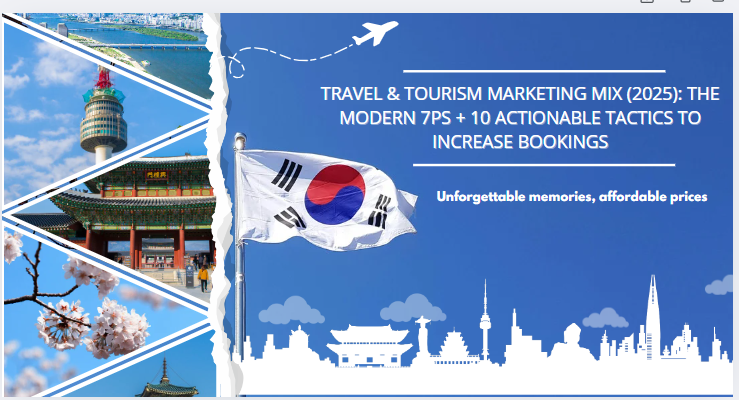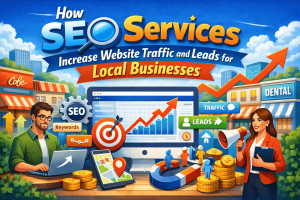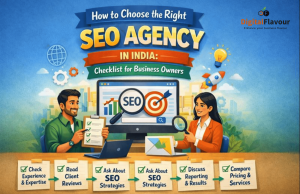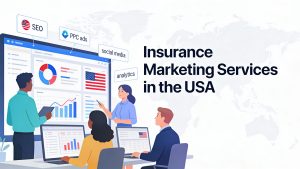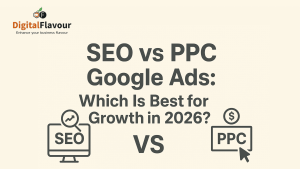The travel and tourism industry is evolving rapidly. From shifting traveler expectations to the dominance of online booking platforms, businesses must stay agile to attract and retain customers. One proven framework that continues to guide successful marketing strategies is the marketing mix.
But here’s the catch: the traditional 7Ps need a modern twist to remain effective in today’s digital-first travel landscape. In this guide, Digital Flavour, Best Digital Marketing Agency will break down the travel and tourism marketing mix, explore the 7Ps with practical examples, and share 10 actionable tactics you can implement right away to boost bookings.
Table of Contents
ToggleWhat is the Travel & Tourism Marketing Mix?
The marketing mix is a strategic framework that helps businesses decide how to present their services, attract customers, and stand out in a competitive market. In the context of travel and tourism, it plays an even more critical role because the “product” being sold is not a physical item — it’s an experience. Whether it’s a weekend getaway, a guided city tour, or a luxury cruise, the success of any travel offering depends on how well it is packaged, priced, promoted, and delivered.
Traditionally, marketers used the 4Ps of marketing — Product, Price, Place, and Promotion — to structure their strategy. For example, a travel agency might define its product as customized holiday packages, set a price based on seasonality, decide the place (online platforms, travel fairs, or partner agents), and focus on promotion through ads and brochures.
However, as the travel industry evolved into a service-driven, highly personalized sector, the 4Ps were no longer enough. This led to the introduction of the 7Ps of services marketing, which add three new elements to the mix:
- People – the staff, guides, and even customer service representatives who directly influence a traveler’s experience.
- Process – the systems and steps that make booking, communication, and service delivery smooth and reliable.
- Physical Evidence – the tangible cues that build trust, such as a professional website, reviews, photos, or even the look and feel of a hotel lobby.
In today’s competitive landscape, travel businesses must understand both the 4Ps and the 7Ps. The first four lay the foundation, while the additional three ensure that the customer journey — from booking to post-trip feedback — is seamless and memorable. This holistic view is what truly defines the travel and tourism marketing mix in 2025.
Why the 7Ps Still Matter in Travel & Tourism
The 7Ps framework may have been introduced decades ago, but it remains highly relevant in the travel and tourism industry, where customer expectations and experiences define success. Unlike physical products, travel services are intangible, perishable, and experience-driven. This makes the additional three Ps — People, Process, and Physical Evidence — just as important as the original four.
Here’s why the 7Ps still matter today:
- Travel is a service, not a product
A beach vacation or a guided trek can’t be “stocked on a shelf.” Once a plane takes off or a hotel room stays empty, that opportunity is gone forever. This makes the marketing mix essential for ensuring every element — from pricing to promotion — aligns with delivering maximum value at the right time. - Customer experience is the product
A traveler’s journey doesn’t start at the destination; it begins with the booking process and ends with post-trip follow-ups. The People who answer queries, the Process that makes booking simple, and the Physical Evidence (reviews, testimonials, professional branding) all shape perceptions before a traveler even boards a plane. - Competition is intense and global
Today, a traveler in Sydney can compare a boutique hotel in Bali with dozens of options on Booking.com within minutes. The 7Ps give tourism businesses a structured way to highlight what makes them different — whether that’s unique experiences (Product), personalized pricing (Price), or local partnerships (Place). - Trust drives conversions
In tourism, trust is everything. High-quality photos, verified reviews, and responsive customer support are part of Physical Evidence and People — and they often make the difference between a booking and a bounce. - Flexibility in a changing market
Tourism is highly sensitive to factors like seasonality, global events, and consumer trends. A well-balanced marketing mix helps businesses adjust quickly — shifting promotions, repricing packages, or improving customer processes to stay competitive.
In short, the 7Ps of the travel and tourism marketing mix are not just theoretical. They provide a practical blueprint that helps travel agencies, tour operators, hotels, and destinations deliver consistent, memorable, and profitable customer experiences.
The Modern 7Ps of the Tourism Marketing Mix (with Examples)
The 7Ps of the tourism marketing mix are more than just theory — they’re a practical guide for how travel businesses can attract, convert, and retain customers in today’s digital-first world. Let’s break down each element with actionable insights and examples.
1. Product: Selling Experiences, Not Just Services
In tourism, the product is the experience. Travelers are buying memories, emotions, and unique moments.
- Example: A boutique safari operator doesn’t just sell “tours.” They position their product as exclusive wildlife encounters with local guides, luxury camps, and cultural immersion.
- Action Tip: Define your unique value proposition (UVP) — what makes your travel package, hotel, or destination different? Use storytelling in your website copy and social media to highlight it.
2. Price: Dynamic and Value-Based Pricing
Tourism is highly seasonal, and customers are price-sensitive. Modern travel brands use dynamic pricing models that adjust based on demand, season, and competition.
- Example: Airlines and OTAs (Online Travel Agencies) like Expedia use real-time pricing engines to maximize occupancy and revenue.
- Action Tip: Bundle services (e.g., hotel + transfer + guided tour) to deliver value while maintaining profitability. Highlight flexible payment options to build trust.
3. Place: Digital Channels and Distribution
Today, place is less about physical presence and more about online accessibility. Travelers research, compare, and book online — often through OTAs, search engines, or directly on a business’s website.
- Example: A small hotel in Bali can reach global customers by optimizing for Google Hotel Ads and leveraging booking platforms like Booking.com and Airbnb.
- Action Tip: Diversify your distribution: use OTAs, but also invest in SEO ( Search Engine Optimization) and direct bookings through your own website to reduce commission costs.
4. Promotion: Multi-Channel Storytelling
Promotion in tourism is about building desire through content, visuals, and customer engagement.
- Example: VisitScotland runs storytelling campaigns showcasing local culture, food, and landscapes across Instagram, TikTok, and YouTube, inspiring travelers to book.
- Action Tip: Combine organic channels (SEO, social media, content marketing) with paid ads (Google Ads, Meta Ads) for maximum reach. Encourage user-generated content (UGC) — it builds authenticity and trust.
5. People: The Human Touch
Travel services are delivered by people, and every interaction shapes the experience. From customer service agents to tour guides, people represent your brand.
- Example: Luxury hotels like The Ritz-Carlton empower staff to make personalized decisions to enhance guest experiences, creating memorable stays.
- Action Tip: Train your team for digital and face-to-face touchpoints. Quick responses on WhatsApp, polite support emails, and friendly in-person service are equally important.
6. Process: Seamless, Tech-Driven Experiences
A smooth booking and service process can make or break a travel experience. Friction leads to frustration, and frustration leads to lost customers.
- Example: Airlines like Emirates simplify processes with mobile boarding passes, real-time flight updates, and multilingual apps.
- Action Tip: Automate confirmations, use chatbots for FAQs, and integrate easy cancellation/refund processes. Transparency and speed improve satisfaction and loyalty.
7. Physical Evidence: Building Trust Before the Trip
Travel is intangible — customers can’t “test” a vacation before purchase. That’s where physical evidence comes in: all the tangible or visible cues that reassure them of quality.
- Example: High-quality photos, 360° virtual tours, verified TripAdvisor reviews, and professional branding on your website are all forms of physical evidence.
- Action Tip: Invest in visuals (photo, video, VR). Encourage happy customers to leave reviews and showcase them prominently. A polished website and consistent branding add credibility.
Key takeaway: The modern 7Ps of the tourism marketing mix provide a roadmap for standing out in a crowded industry. By combining traditional principles with digital strategies — SEO, dynamic pricing, social media, and seamless tech — travel businesses can build trust, attract more bookings, and deliver unforgettable experiences.
10 Actionable Tactics to Boost Bookings in 2025
The 7Ps framework gives travel businesses a solid foundation — but in today’s competitive market, success comes from applying it with modern marketing tactics. Here are ten proven strategies you can use in 2025 to stand out, build trust, and increase bookings.
1. Harness User-Generated Content (UGC)
Travelers trust real experiences over polished ads. Encourage customers to share photos, videos, and testimonials.
- How it fits: Physical Evidence + Promotion
- Action Tip: Create branded hashtags or run contests where guests can win discounts for sharing their trip moments.
2. Invest in Short-Form Video Marketing
Platforms like Instagram Reels, TikTok, and YouTube Shorts are where travelers discover destinations.
- How it fits: Promotion
- Action Tip: Showcase behind-the-scenes stories — from a chef preparing local food to drone shots of hidden gems. Keep it authentic and snackable.
3. Optimize for “Near Me” and Local SEO
Many travelers search on the go — “best hotels near me” or “tours near me.”
- How it fits: Place + Promotion
- Action Tip: Claim and optimize your Google Business Profile with updated hours, photos, and reviews.
4. Offer Flexible Booking and Cancellation Policies
Flexibility is now a booking decision factor post-pandemic.
- How it fits: Price + Process
- Action Tip: Highlight flexible cancellations and payment options on your website and ads.
5. Run Seasonal & Dynamic Pricing Campaigns
Tourism demand fluctuates with holidays, school breaks, and global events.
- How it fits: Price
- Action Tip: Use data analytics or simple booking trends to adjust prices. Offer early-bird or last-minute deals to capture demand spikes.
6. Partner with Influencers and Micro-Creators
Travel influencers can amplify your reach and build trust with niche audiences.
- How it fits: Promotion + People
- Action Tip: Work with micro-influencers (5K–50K followers) who have engaged audiences in your niche (adventure, wellness, family travel).
7. Improve Mobile Booking Experiences
Most bookings now happen via mobile devices. A clunky mobile site means lost customers.
- How it fits: Process
- Action Tip: Ensure your website loads in under 3 seconds, integrates mobile wallets, and offers one-click booking.
8. Create Personalized Travel Packages
Travelers want customization — from dietary needs to offbeat activities.
- How it fits: Product + People
- Action Tip: Offer quizzes or booking forms that help design personalized itineraries. Promote these as unique “tailor-made experiences.”
9. Use Retargeting Ads to Recover Lost Leads
Not every website visitor books on their first visit. Retargeting helps bring them back.
- How it fits: Promotion
- Action Tip: Show dynamic retargeting ads featuring the exact tour or hotel they viewed, paired with a special discount.
10. Build Loyalty Through Reviews & Referrals
Reviews not only influence new bookings but also build repeat customers.
- How it fits: People + Physical Evidence
- Action Tip: Send automated follow-up emails asking guests to review their experience. Offer referral bonuses for recommending friends.
Pro Tip: Start small — don’t try all 10 at once. Pick 2–3 tactics that align with your current marketing goals and build momentum. For example, a boutique hotel might start with local SEO, short-form video, and loyalty referrals, while a tour operator might focus on influencer partnerships and UGC.
Measuring Success: Marketing Mix Modelling (MMM) & Seasonality
Having the right marketing mix in place is only half the journey — knowing whether it’s working profitably is what truly drives growth. In the travel and tourism industry, measuring results can be challenging because customer journeys are long, involve multiple touchpoints, and are heavily influenced by seasonality. This is where Marketing Mix Modelling (MMM) comes in.
What is Marketing Mix Modelling (MMM)?
Marketing Mix Modelling is a data-driven approach that analyzes past performance to understand how different marketing channels — such as SEO, social media, paid ads, or offline promotions — contribute to sales and bookings.
- Example: An adventure tour company may learn that 40% of its bookings come from organic search during summer months, while paid social ads perform better in the off-season.
- Why it matters: MMM helps travel businesses allocate budgets smarter, reduce wasted ad spend, and focus on channels that deliver real ROI.
Why Seasonality Matters in Tourism
Unlike other industries, travel demand is highly seasonal. Holidays, school breaks, weather, and even global events influence bookings.
- Example: Ski resorts see demand spike in winter, while beach destinations peak in summer. Airlines adjust pricing months in advance to match these shifts.
- Action Tip: Incorporate seasonal data into your marketing mix. Promote early-bird packages before peak months and offer attractive discounts in off-peak periods to maintain cash flow.
Key Metrics Every Travel Business Should Track
To measure success, focus on metrics that tie directly to your goals:
- Cost per Booking (CPB): Total spend ÷ number of confirmed bookings.
- Booking Conversion Rate: Website visitors who complete a booking.
- Lifetime Value (LTV): Total revenue generated by a customer across repeat bookings.
- Channel ROI: Return on investment for SEO, ads, social, email, and influencer campaigns.
- Review & Referral Rate: Percentage of customers who leave reviews or refer friends.
How to Apply MMM & Seasonality Together
- Collect at least 12–24 months of marketing and sales data.
- Break down performance marketing by channel, season, and campaign type.
- Use simple models (spreadsheets or analytics dashboards) or advanced MMM tools if available.
- Test adjustments — e.g., reduce low-performing ad spend in off-peak months and double down on organic or referral marketing.
Pro Tip: You don’t need enterprise-level tools to start with MMM. Even small travel businesses can use free tools like Google Analytics, GA4 attribution reports, or Excel dashboards to understand seasonal patterns and marketing ROI.
7-Step Checklist for Implementing Your Travel Marketing Mix
Building a marketing mix is one thing — putting it into action is another. To make it easier, here’s a 7-step checklist you can use to implement your travel and tourism marketing mix effectively in 2025.
Step 1: Define Your Core Offering (Product)
- Identify what makes your travel service unique — is it adventure, luxury, culture, or affordability?
- Package experiences with clear value propositions (e.g., “eco-friendly jungle safaris” or “all-inclusive family beach getaways”).
Step 2: Set Competitive and Flexible Pricing (Price)
- Research competitor pricing for similar packages.
- Offer early-bird discounts, seasonal pricing, and flexible cancellations to attract more bookings.
Step 3: Choose the Right Distribution Channels (Place)
- List where customers can find and book you: website, OTAs, social media, or local partners.
- Prioritize direct bookings to reduce commission costs and build stronger customer relationships.
Step 4: Build a Multi-Channel Promotion Strategy (Promotion)
- Combine SEO, paid ads, email marketing, and social media storytelling.
- Encourage UGC (user-generated content) and influencer partnerships to increase trust.
Step 5: Train and Empower Your People (People)
- Ensure frontline staff and digital support teams deliver consistent, friendly service.
- Train them in both customer service and digital communication (email, WhatsApp, chatbots).
Step 6: Streamline Booking and Service Delivery (Process)
- Use automation for confirmations, reminders, and feedback requests.
- Make the booking journey seamless across desktop and mobile devices.
Step 7: Strengthen Trust with Tangible Proof (Physical Evidence)
- Invest in high-quality photos, videos, and virtual tours.
- Display verified reviews and testimonials prominently on your site and Google Business Profile.
How to use this checklist: Print it, share it with your team, and review it quarterly. Each step corresponds to one of the 7Ps, ensuring your marketing mix remains balanced, customer-focused, and results-driven.
Pro Tip: Keep your mix dynamic — revisit these steps as trends, customer needs, and seasonal demand shift. Flexibility is the secret to long-term success in tourism marketing.
How Digital Flavour Can Help
At Digital Flavour, Best Digital Marketing Agency, we specialize in helping travel and tourism businesses turn strategy into results. From SEO-optimized content to paid ad campaigns, influencer partnerships, and ROI measurement, we provide end-to-end solutions tailored to your goals.
Ready to grow your bookings? Book a free 30-minute strategy call today.
FAQs About Travel & Tourism Marketing Mix
1. What are the 7Ps of tourism marketing?
The 7Ps are Product, Price, Place, Promotion, People, Process, and Physical Evidence.
2. Why is the marketing mix important in tourism?
It ensures all elements of your business — from packages to promotions — are aligned with customer expectations and industry trends.
3. How can small travel agencies use the marketing mix?
Focus on niche travel products, invest in UGC, use affordable digital tools, and measure success with simple KPIs.
4. How does seasonality affect tourism marketing?
Travel demand varies across seasons. Adjust pricing, promotions, and budgets accordingly to maximize ROI.
Final Thoughts
The travel and tourism marketing mix remains a powerful framework in 2025 — but only if updated with modern tactics. By combining the 7Ps with data-driven strategies, storytelling, and seamless processes, travel businesses can stand out, attract more customers, and grow bookings.
Ready to build your winning marketing mix? Contact Digital Flavour today for a free audit.
Author
-
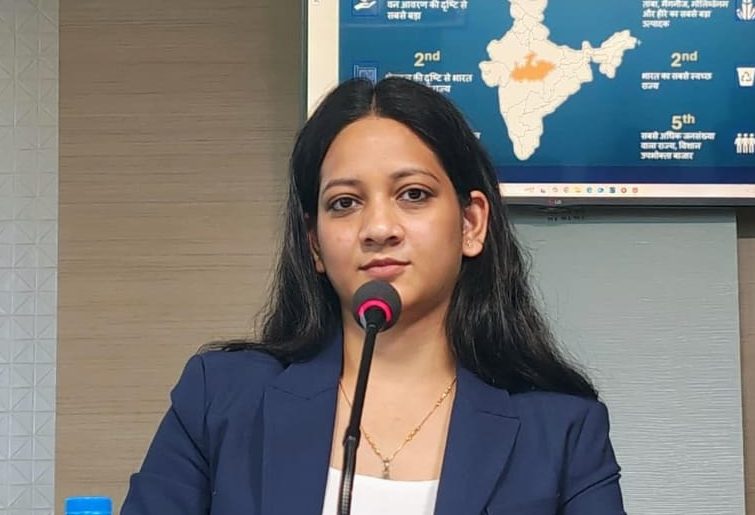
Ragini Neema is the founder & CEO of Digital Flavour, Indore’s leading digital marketing agency helping startups and businesses scale into powerful brands. With expertise in SEO, Social media marketing, paid advertising, and Web development, has positioned Digital Flavour as a trusted growth partner for companies that aim to go big. Recognized as a digital marketing expert, Ragini blends strategy, creativity, and innovation to deliver measurable results in today’s competitive online world.

